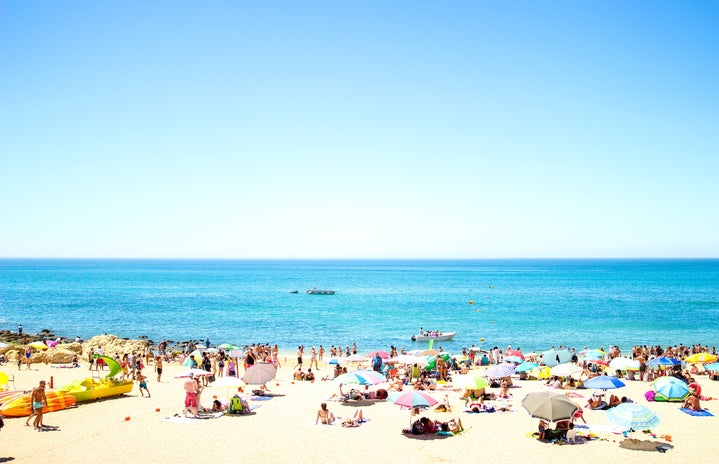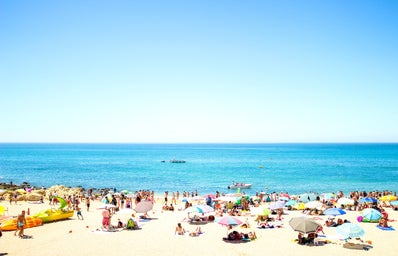You’ve worked hard in class, stayed up late nights and survived the bitter cold all semester. Spring break is finally here, one full week of being lazy by day, making memories by night, and not worrying about a thing — until you find yourself dealing with a stinging sunburn and a raging headache. We hate to be the bearer of bad news, but while you can take a break from a lot of things — tests, papers, problem sets, office hours — staying healthy isn’t one of them. Read on for tips on how to avoid spring vacation’s most common health dilemmas.
Sunburn
After months of being covered up under layers clothing, your skin is ready to see the light of day again — preferably by tanning under the sun, in some equatorial country, at high noon. Sounds hot, right? Not so fast. The United States Environmental Protection Agency reports several adverse long-term effects of repeated overexposure to the sun: skin damage, immune suppression, and skin cancer — the most common form of cancer in the U.S. But even if you’re thinking in terms of days and not years, don’t forget just how unpleasant sunburns are: they’re painful and itchy, and especially hurt under the sun or in the shower. On top of that, your ploy to get guys with a nice tan can backfire — there’s nothing attractive about a splotchy, peeling sunburn, and you’ll probably need to cover it up anyway.
To avoid sunburn, the Skin Cancer Foundation recommends applying sunscreen with an SPF of at least 30 half an hour before going outside and reapplying after every two hours of swimming or sweating. You can find affordable brands like Coppertone®, Banana Boat® and Neutrogena® at your local drugstore, all of which provide sunscreens for various uses: Neutrogena, for example, offers a line of “Wet Skin” sunblock designed to last even while you swim, as well as oil-free lotion with SPF 45 if you’re looking to avoid that greasy feel. If you don’t want to deal with the hassle of rubbing in lotion, try a spray and look into makeup with sun protection — Bare Escentuals® sells matte and powder foundations with SPF 15, and products like Colorescience® Sunforgettable SPF 30 Powder and Jergens® Natural Glow Facial Moisturizer SPF 20 for various skin tones even have the Skin Cancer Foundation’s seal of approval. So take your pick, apply it regularly and make sure to take breaks in the shade, too; not only will you avoid a next-day sunburn, but you’ll be better off in the long-run, too.
Swimmer’s Ear
Don’t let the name fool you! Swimmer’s ear can be caused by swimming in water contaminated with bacteria or fungi, but according to Medline Plus®, the National Institute of Health’s online resource, you can also get it from scratching your ear frequently, irritation of the bone and tissues around that area, and — don’t even tell us how this happened — getting a foreign object stuck in your ear. Not to be confused with “airplane ear,” the ear pressure you can sometimes feel at high altitudes, swimmer’s ear can cause drainage, itchiness, and impaired hearing. Those symptoms can all be painful (and let’s be real, kind of gross), so take the appropriate preventative measures: Medline Plus® advises that you keep your ears clean, avoid scratching or inserting cotton swabs, and dry your ears after they are exposed to water. As for evading polluted waters, nobody expects you to analyze each lake with a Petri dish 24 hours before every spontaneous skinny dipping adventure. Just use your best judgment and follow the steps above no matter where you swim.
Stomach Flu
We don’t want to get too graphic, but there’s a reason why Emily in The Devil Wears Prada says, “I’m just one stomach flu away from my goal weight” — it’s because the stomach flu can get ugly. According to the Mayo Clinic, victims of stomach flu can suffer from vomiting, diarrhea, nausea, cramps, headaches and fever — which adds up to a spring break that’s “unforgettable” in a totally different sense than you intended. Technically called gastroenteritis, stomach flu is often caused by consuming contaminated food and water, though you can also get it from eating irritating or spoiled foods, catching a virus or picking up a parasite. Scared you’ll catch it? Mayo Clinic advises you to prevent the spread of germs by washing your hands, avoiding undercooked foods and getting the appropriate vaccinations. If your spring break destination spot is somewhere you know the food and water sources can be unclean, stick to bottled water and pack meal bars for times when your options are limited. Same goes for your own hygiene — remember that you’re sharing the beach and seawaters with tons of other people, so keep a sanitizer like Purell® or Germ-X® on hand for when you’re snacking on the beach.
Dehydration
Dehydration is often something we associate with alcohol consumption, but it can also hit after prolonged exposure to sun and heat — which definitely isn’t a rarity over spring break. “Just like how bars put salty snacks out to make you thirsty and drink more, don’t let the sun do the same thing to you,” says Katie Clark, MPH, RD, CDE, Assistant Clinical Professor at the University of California, San Francisco. “Sip your drinks; gulp your water — especially when you’re in the sun.” And while we’re focusing on how dehydrating the spring break weather can be, alcohol can exacerbate the problem. “If you do choose to drink alcohol,” adds Clark, “for every drink you have, make sure to have the equivalent of one cup of water before your next drink.” Enjoy the sandy beaches and beautiful weather, but keep a reusable water bottle with you throughout the day so that you’ll have a convenient way to stay hydrated.
Hangover
So you’re finally of age and you can’t wait to try out that bar in Myrtle Beach you’ve pined after every spring break. Have fun, but remember that your tolerance hasn’t gone up just because you’re on vacation. Going too crazy will hurt in the morning, so know your limits and stick to them. “Remember that your body’s liver has the capacity to detoxify approximately one drink per hour,” says Clark. “If you drink more than one drink per hour, you are outpacing your liver’s detoxification capabilities, and you will pay the price!” The symptoms of a nasty hangover include headaches, nausea, fatigue and dehydration (you already know our spiel on that one) — none of which are worth the extra shots you took last night. Watch your alcohol intake, and remember to eat something substantial before; think lean meat, tofu, whole grains and vegetables at meals, and bars like Luna® when you’re on the go (they’re packed with protein and fiber). “Having food in your stomach acts as a buffer, and helps to slow the direct absorption of alcohol,” adds Clark. “To lengthen the time to intoxication — and ultimately mitigate the effects of a potential hangover — have a snack or meal with some protein, fat and fiber before you start drinking.”
Have a blast tonight, feel great tomorrow — that doesn’t sound like a bad break at all.
Photo Credits:
http://greatusefulstuff.files.wordpress.com/2011/07/man_woman_sunscreen1…
http://1.bp.blogspot.com/–dW-h6uuroY/TlFyd_TolMI/AAAAAAAAAj0/nT-S7anj5U…
http://care4healthy.com/wp-content/uploads/2010/12/59977_nyeri_menstruas…
http://www.mineral-makeup-reviews.com/image-files/colorescience-sunforge…

